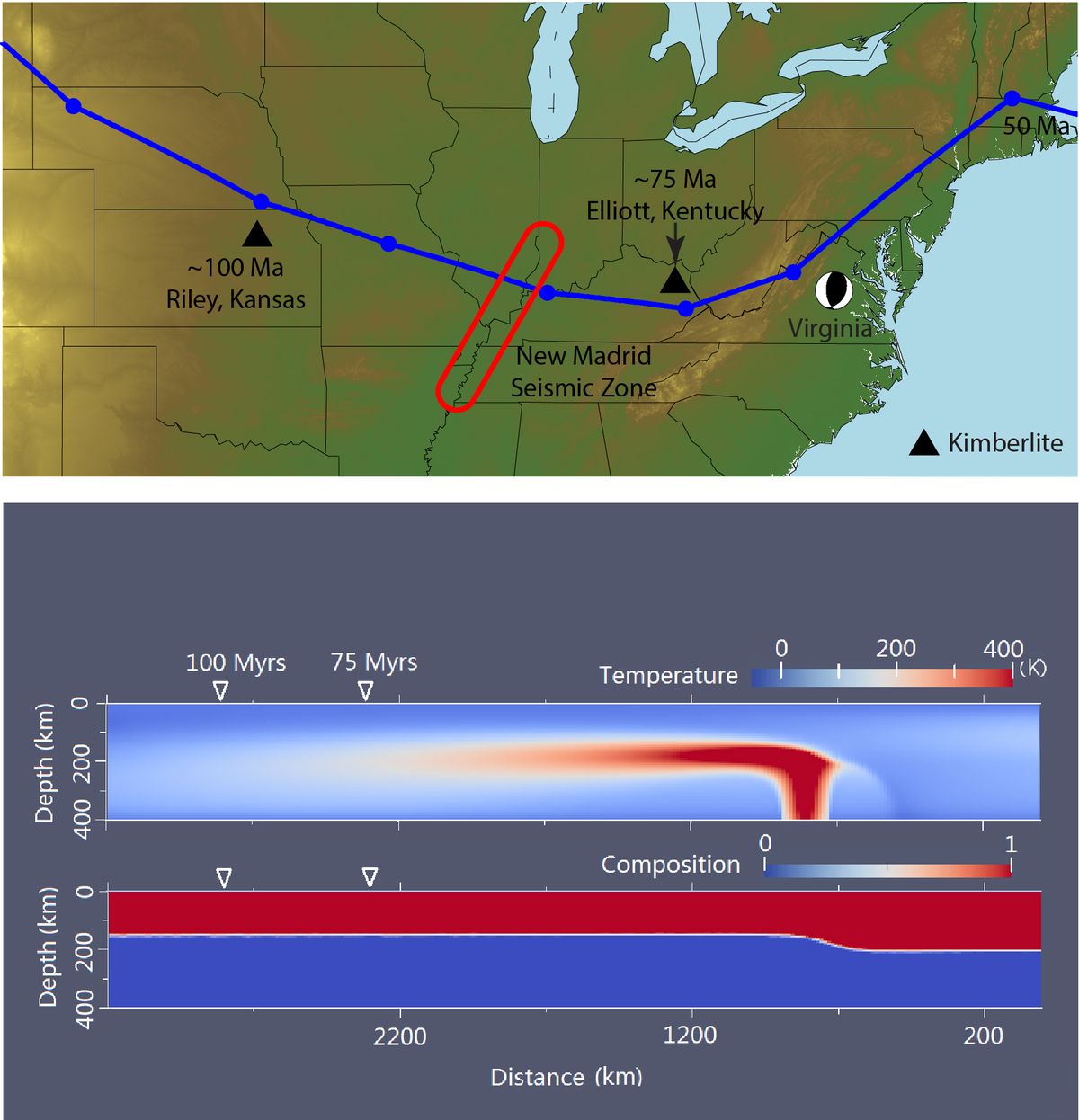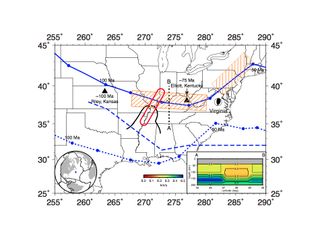
Hotspot Scorched Midwest, Leaving Legacy of Earthquakes, Rare Rocks

A seismic speed trap that stretches from Missouri to Virginia suggests a hotspot scorched the Midwest during the Mesozoic Era, a new study finds.
Hotspots are scalding plumes of hot rock rising toward Earth's surface from the mantle, the layer that sits under Earth's crust. Though tectonic plates constantly shift, hotspots are homebodies, stuck in pretty much the same spot for their entire lives, scientists think.
When continents trundle across hotspots, the plumes burn their bottoms, like a cold plate passed over a flame. For the first time, scientists have spied one of these warm trails under North America's midriff, according to a study published today (Sept. 15) in the journal Nature Geoscience.

The study authors think the hot zone lines up with rare rocks called kimberlites in Kansas and Kentucky. The deep-seated heating also accounts for thinning of the crust and intrusions of magma along the New Madrid rift during the Mesozoic, the researchers said. The New Madrid rift is a seismic zone in the central Mississippi Valley that split open in the Early Cambrian period and reactivated during the Mesozoic. During the winter of 1811 to 1812, three powerful earthquakes in the rift shook New Madrid, Mo., and rattled buildings as far away as New York and Washington, D.C.
"I think this is all very exciting because it means that the continent is not as boring as everybody thought it was," said study co-author Don Helmberger, a Caltech seismologist. "I grew up in the Midwest and thought this was the worst place in the world [for geology]."
Connecting the dots
Because kimberlites speckle the Midwest, for decades geologists have suggested North America glided over a hotspot as it marched westward for the past 100 million years. Though the Kansas and Kentucky kimberlites are diamond-free, in Canada and Africa, diamond-bearing kimberlites bubbled up above hotspots. The magma that creates kimberlites travels hundreds of kilometers in mere days, exploding violently once it reaches the surface. It's as if the Earth farts diamonds. [Sinister Sparkle Gallery: 13 Mysterious & Cursed Gemstones]
Sign up for the Live Science daily newsletter now
Get the world’s most fascinating discoveries delivered straight to your inbox.
Until now, no one had seen telltale signs of a hotspot beneath the K-state kimberlites.
"People have always thought these were caused by a hotspot, but no one had proof," Helmberger said.
Finally, in 2011, the combination of a rare East Coast earthquake and the placement of the USArray, a dense traveling seismometer network, gave researchers a clear look under the Midwest. "You have to have some luck to get a foothold on the interesting stuff, you know," Helmberger told LiveScience's OurAmazingPlanet.
Slow and low
The massive array of more than 500 seismometers, instruments that measure earthquake waves, spied an unusually slow zone beneath North America during the 2011 Virginia earthquake. This seismic "low-velocity" lane cuts west to east from Missouri to Virginia, then jogs north to Massachusetts and continues offshore. The corridor is 25 miles (40 kilometers) thick, and lies 75 miles to 100 miles (120 to 160 km) below the surface, said Risheng Chu, lead study author and a geophysicist with the Institute of Geodesy and Geophysics at the Chinese Academy of Sciences in Beijing. The zone also appears in other earthquakes, Chu said in an email interview.
A computer model of the hotspot's heating suggests it could have created the slow zone, the researchers report. Higher temperatures in rocks can hinder seismic waves. For example, the model's predicted temperatures match the real-world seismic slowing one might see if a hotspot passed under Kentucky 75 million years ago, when the state's kimberlites punched through the crust, the study finds.
"This is a hidden track, meaning it's way down there, but it's still a couple hundred degrees hotter than it normally would be," Helmberger said.
But other than the kimberlites and the New Madrid rift getting hotter and thinner in the Mesozoic, Chu and his colleagues found no other geologic connections to the hotspot. But geophysicist Cindy Ebinger, who wasn't involved in the study, notes that Virginia has a couple volcanoes in the right place at the right time, and there are kimberlites in Pennsylvania and New York. [In Images: How North America Grew As a Continent]
Ebinger said the team's evidence for seismic velocity differences under North America was "unquestionable," but the link to surface geology was more tenuous.
"The age part starts with a guess based on a few pieces of circumstantial evidence," said Ebinger, a professor at the University of Rochester in New York. "Maybe there are other features and other tracks they could connect to. I think this will motivate new and better studies that will take it out of the speculative range."
East Coast flow
Chu and his colleagues believe the hot spot now sits under the flat, featureless Sohm Plain, north of a chain of unrelated volcanic islands called the New England Seamounts. (In fact, the seamounts formed about 110 to 80 million years ago over the Great Meteor mantle plume). They hope to confirm their suspicions with the mobile seismometer network, which shifted east of the Appalachians this year, Helmberger said.
"This is a novel interpretation that will be testable as EarthScope moves eastward," said Ebinger, referring to the traveling seismometer network. Ebinger said she expects the network will reveal that the East Coast isn't as simple as textbooks predict.
"It's exciting to see that new discoveries are being made about the structure and perhaps even the evolution of the continental lithosphere of North America," she told LiveScience's OurAmazingPlanet.
"There will be more surprises," Ebinger said.
Email Becky Oskin or follow her @beckyoskin. Follow us @OAPlanet, Facebook & Google+. Original article on LiveScience's OurAmazingPlanet.












